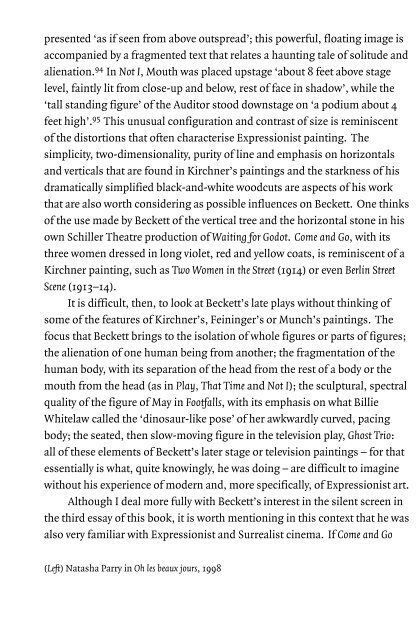You also want an ePaper? Increase the reach of your titles
YUMPU automatically turns print PDFs into web optimized ePapers that Google loves.
presented ‘as if seen from above outspread’; this powerful, floating image is<br />
accompanied by a fragmented text that relates a haunting tale <strong>of</strong> solitude and<br />
alienation. 94 In Not I, Mouth was placed upstage ‘about 8 feet above stage<br />
level, faintly lit from close-up and below, rest <strong>of</strong> face in shadow’, while the<br />
‘tall standing figure’ <strong>of</strong> the Auditor stood downstage on ‘a podium about 4<br />
feet high’. 95 This unusual configuration and contrast <strong>of</strong> size is reminiscent<br />
<strong>of</strong> the distortions that <strong>of</strong>ten characterise Expressionist painting. The<br />
simplicity, two-dimensionality, purity <strong>of</strong> line and emphasis on horizontals<br />
and verticals that are found in Kirchner’s paintings and the starkness <strong>of</strong> his<br />
dramatically simplified black-and-white woodcuts are aspects <strong>of</strong> his work<br />
that are also worth considering as possible influences on <strong>Beckett</strong>. One thinks<br />
<strong>of</strong> the use made by <strong>Beckett</strong> <strong>of</strong> the vertical tree and the horizontal stone in his<br />
own Schiller Theatre production <strong>of</strong> Waiting for Godot. Come and Go, with its<br />
three women dressed in long violet, red and yellow coats, is reminiscent <strong>of</strong> a<br />
Kirchner painting, such as Two Women in the Street (1914) or even Berlin Street<br />
Scene (1913–14).<br />
It is difficult, then, to look at <strong>Beckett</strong>’s late plays without thinking <strong>of</strong><br />
some <strong>of</strong> the features <strong>of</strong> Kirchner’s, Feininger’s or Munch’s paintings. The<br />
focus that <strong>Beckett</strong> brings to the isolation <strong>of</strong> whole figures or parts <strong>of</strong> figures;<br />
the alienation <strong>of</strong> one human being from another; the fragmentation <strong>of</strong> the<br />
human body, with its separation <strong>of</strong> the head from the rest <strong>of</strong> a body or the<br />
mouth from the head (as in Play, That Time and Not I); the sculptural, spectral<br />
quality <strong>of</strong> the figure <strong>of</strong> May in Footfalls, with its emphasis on what Billie<br />
Whitelaw called the ‘dinosaur-like pose’ <strong>of</strong> her awkwardly curved, pacing<br />
body; the seated, then slow-moving figure in the television play, Ghost Trio:<br />
all <strong>of</strong> these elements <strong>of</strong> <strong>Beckett</strong>’s later stage or television paintings – for that<br />
essentially is what, quite knowingly, he was doing – are difficult to imagine<br />
without his experience <strong>of</strong> modern and, more specifically, <strong>of</strong> Expressionist art.<br />
Although I deal more fully with <strong>Beckett</strong>’s interest in the silent screen in<br />
the third essay <strong>of</strong> this book, it is worth mentioning in this context that he was<br />
also very familiar with Expressionist and Surrealist cinema. If Come and Go<br />
(Left) Natasha Parry in Oh les beaux jours, 1998<br />
IMAGES OF BECKETT 91


